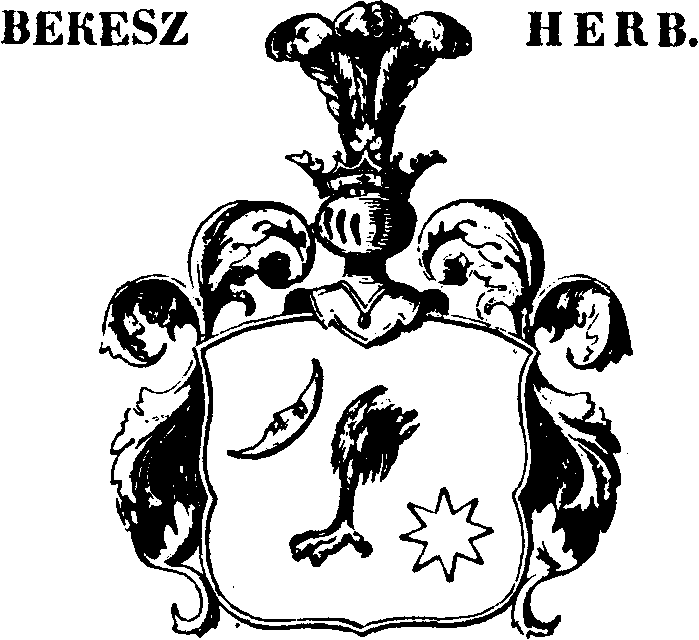Herb Bekesz
Research Heraldry Herb Bekesz
Herbarz Polski translation
Bekesz herb
 The following article is a direct translation from the classic Genealogical and Heraldic reference "Herbarz Polski" by Kasper Niesiecki S.J., (Lipsk) edition 1839-46.
The following article is a direct translation from the classic Genealogical and Heraldic reference "Herbarz Polski" by Kasper Niesiecki S.J., (Lipsk) edition 1839-46.
The leg of an eagle is centered in a brown field. Its upper feathered part is black and the claw is in gold. A quarter moon is to one side of the leg, and an eight-pointed star is on the other. Above the shield is a crowned helmet from which three ostrich plumes project. (Rutka, Okolski).
This coat of arms is of Hungarian origin and similar to Topacz.
KASPER BEKESZ (whose father had been an emissary of Queen Isabella of Hungary to the Turkish Tsar Soliman) successfully negotiated a peace treaty in Vienna when he was a Chamberlain in the court of Jan Zygmunt, Prince of Siedmiogrodz.
After two trips to Constantinople, Kasper so captivated the monarch with his abilities and magnanimous heart, that he was awarded the moon and star in the coat of arms of his ancestors. Kasper enjoyed such wide respect that, when Jan died, he boldly fought Stefan Batory's claim to Siedmiogrodz. Having lost, Kasper left the country. However, when Batory became King of Poland, Bekesz approached him apologetically, and the King responded graciously by making Kasper and his brother, Gabriel, Generals. One commanded the cavalry and the other, the infantry. They served their King faithfully. Gabriel lost his life in battle against Moscow at Pleszkowski castle when he was shot twice after his horse was wounded. Kasper succumbed after many valiant campaigns which drained his strength and health.
Thanks to the deeds of their father and uncle, GABRIEL and WLADYSLAW BEKESZ were conferred honorary citizenship (1593) and given access to all high offices in the Kingdom, as well as, in the Duchy of Lithuania (Okolski).
When his father died, WLADYSLAW was cared for by King Stefan Batory who sent him to Wilno for studies, and then to the College at Pultusk. Wladyslaw became head of Wschow (starosta Wschowski), a courtier, and a captain of the royal cavalry. He joined the camp of Zygmunt III. In his first expedition at Byczyna, against Prince Maximilian of Austria, Wladyslaw was wounded in the neck and hand, but despite the loss of blood would not leave the battlefield. When the warring era in Hungary began, Wladyslaw gathered quite a large force and hurried to the assistance of Prince Maciej at Jauryn. In one charge, one hundred Turks were killed, 148 were taken prisoner, and 400 retreated from the field. Wladyslaw brought 49 of the camels and mules to camp. On his return to Poland, he joined King Zygmunt in battling the Swedes. Wladyslaw suffered many difficulties while defending Kolmarski's castle in Sweden. For his services, the King awarded him a section of Wschow County and the subprefectures: Prennenskie, Bastawskie, and Hanselenskie.
Copyright © 1983 Josephine M. Piegzik. Used by permission. This article originally appeared in Polish Genealogical Society Newsletter (Vol. 5, No. 2, Fall 1983), the journal of the Polish Genealogical Society (of America).
;
